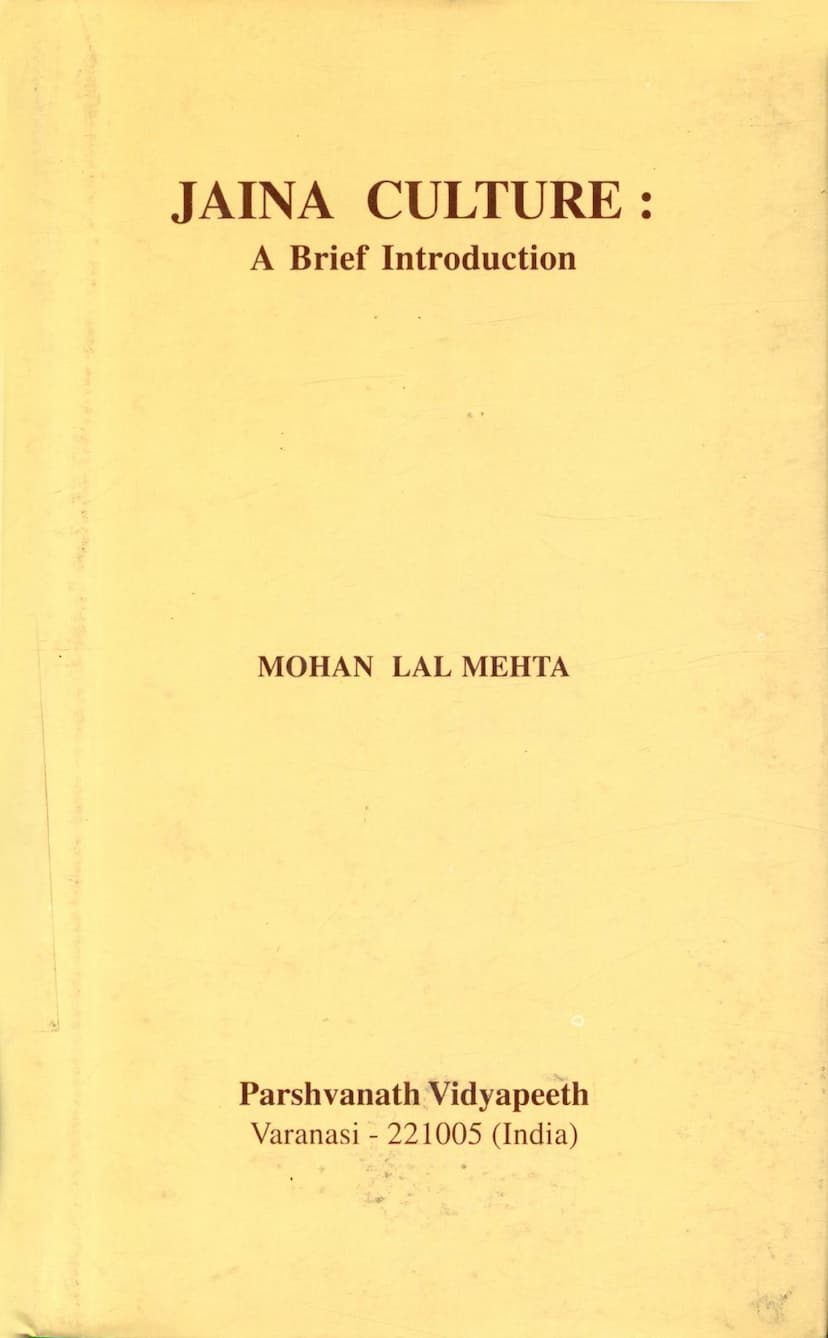Jaina Culture
Added to library: September 2, 2025

Summary
Here's a comprehensive summary of the Jain text "Jaina Culture: A Brief Introduction" by Mohan Lal Mehta, based on the provided pages:
Book Overview:
"Jaina Culture: A Brief Introduction" by Mohan Lal Mehta, published by Parshvanath Vidyapeeth, Varanasi, in 2002, is the second edition of a work originally published in 1969. The book aims to provide a concise yet comprehensive introduction to the various facets of Jaina culture, presented as a significant branch of Indian culture.
Author's Credentials:
Dr. Mohan Lal Mehta is presented as an internationally recognized scholar of Jainism. His expertise spans Jaina Philosophy, Psychology, Epistemology, Culture, and Literature. He is the author of the monumental "Prakrit Proper Names" and has held prestigious positions such as the founder Director of the P. V. Research Institute, Varanasi, and the founder Professor of Jaina Philosophy at the University of Poona.
Structure and Content:
The treatise is organized into nine chapters, covering the following key areas:
-
Antiquity and History: This chapter explores the origins and historical development of Jainism, situating it within the broader context of Indian culture. It highlights Jainism's independence and ancient roots, tracing its lineage back to the Indus Valley Civilization. Key historical figures like Pārśva, Mahāvīra, and significant events and divisions within Jainism (Digambaras and Śvetāmbaras) are discussed. The relationship between Jaina and Dravidian cultures, as well as Jainism and Buddhism, is also examined.
-
Literature: This extensive chapter delves into the vast corpus of Jaina literature, categorizing it into canonical texts (Angas, Upangas, Mūlasūtras, Chedasūtras, Culikāsūtras, and Prakirņakas) and their commentaries. It details the structure and content of numerous significant works and highlights the efforts of Jaina monks in preserving and systematizing their scriptures through councils.
-
Reality: This chapter outlines the Jaina metaphysical perspective on reality. It identifies six fundamental substances (soul, matter, medium of motion, medium of rest, space, and time) and elaborates on their characteristics. The nature of the soul (jiva), matter (pudgala), and the concept of karma as an obscuring agent are discussed.
-
Knowledge: This chapter focuses on the Jaina epistemology, detailing the different types of knowledge. It distinguishes between apprehension (darśana) and comprehension (jñāna) and further classifies comprehension into five types: sensory, scriptural, clairvoyance, telepathy, and omniscience. The role of sense-organs and the mind in acquiring knowledge is also explained.
-
Relativism: This chapter introduces the core Jaina philosophical principles of Syadvada (non-absolutism) and Nayavada (theory of standpoints). It explains the sevenfold judgment and how it reflects the multifaceted nature of reality, where seemingly contradictory attributes can coexist when viewed from different perspectives.
-
Karma and Liberation: This chapter provides a detailed explanation of the Jaina doctrine of karma, including its meaning, nature, duration, intensity, and quantity. It discusses karma's role in bondage and the process of liberation. The eight fundamental types of karma and their numerous subtypes are described, along with the fourteen stages of spiritual development (guṇasthānas) that lead to liberation. Meditation and its types are also covered.
-
Transmigration: This chapter explores the Jaina concept of rebirth and the soul's journey through various states of existence. It describes the different forms of life: infernal beings, human beings, Tirthankaras, animal beings, and celestial beings (Residential, Peripatetic, Stellar, and Heavenly gods). The law of karma is presented as the governing principle behind these transmigratory cycles.
-
Conduct: This chapter outlines the ethical framework of Jainism, focusing on the vows observed by lay-votaries (small vows or anuvratas) and ascetics (great vows or mahāvratas). It details the five core vows (non-violence, truthfulness, non-stealing, celibacy/chastity, and non-possession), along with supplementary vows for laypeople. The importance of conduct over birth in defining social classes within Jaina culture is emphasized.
-
Art and Architecture: This final chapter discusses the significant contributions of Jainism to Indian art and architecture. It covers Jaina iconography, early Jaina icons, cave temples, stūpas, iconic representations of Tirthankaras, and famous Jaina architectural marvels like the Colossus of Gommateśvara and the Dilwara Temples. The chapter also touches upon Jaina painting, both wall paintings and miniature paintings.
Key Themes and Concepts:
- Indian Culture as Composite: The book emphasizes that Indian culture is a composite blend, with Brahmanism and Śramanism (including Jainism and Buddhism) as its two dominant trends.
- Jainism's Antiquity and Independence: Mehta strongly asserts that Jainism is an ancient and independent religion, predating Vedic religion and not merely a revolt against it.
- Emphasis on Conduct: Jaina culture is characterized by its focus on righteous conduct and spiritual discipline rather than birth or caste.
- The Doctrine of Karma: Karma is central to Jaina philosophy, explaining the cycle of birth, death, and rebirth and the experiences of individuals.
- Non-Absolutism (Syadvada): The philosophy of viewing reality from multiple perspectives is a cornerstone of Jaina thought.
- Non-Violence (Ahimsa): This is the paramount principle, influencing all aspects of Jaina ethics and practice.
- Asceticism and Liberation: The path to liberation involves rigorous self-discipline, renunciation, and the annihilation of karma.
- Rich Literary and Artistic Heritage: Jainism has a vast and significant body of literature and has made considerable contributions to Indian art and architecture.
In essence, "Jaina Culture: A Brief Introduction" serves as a valuable resource for understanding the philosophical underpinnings, historical development, ethical principles, and cultural expressions of Jainism.